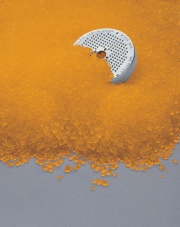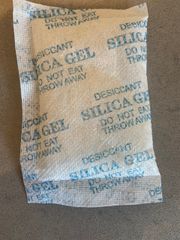Difference between revisions of "Silica gel"
| Line 3: | Line 3: | ||
== Description == | == Description == | ||
| − | A crystalline material of [[silica|silica]] available as granuleas powder of beads. Silica gel is chemically inert, very porous, and hygroscopic. It is used as a pollutant sorbent and as a humidity buffering agent. Silica gel absorbs moisture in humid environments and releases water in dry air. Once equilibrated to set moisture level, silica gel will maintain that humidity level in a closed environment. Examples of silica gel products preconditioned as humidity buffers are [[Art-Sorb|Art-Sorb®]], [[Arten Gel|Arten gel]] and [[Gore-Tex|GORE-TEX®]] silica tiles. Silica gel that is saturated with water can regenerated with heat (120 C for 2 hours) and used again. Some brands of commercial silica gel include [[cobaltous%20chloride|cobalt chloride]] as a humidity indicator (blue when dry and pink when moist). Silica gel has also been used as a [[desiccant]] in [[Dri-die|Dri-die]] cockroach formulation. | + | A crystalline material of [[silica|silica]] available as granuleas powder of beads. Silica gel is chemically inert, very porous, and hygroscopic. It is used as a pollutant sorbent and as a humidity buffering agent. Silica gel absorbs moisture in humid environments and releases water in dry air. Once equilibrated to set moisture level, silica gel will maintain that humidity level in a closed environment. |
| + | |||
| + | Examples of silica gel products preconditioned as humidity buffers are [[Art-Sorb|Art-Sorb®]], [[Arten Gel|Arten gel]] and [[Gore-Tex|GORE-TEX®]] silica tiles. Silica gel that is saturated with water can regenerated with heat (120 C for 2 hours) and used again. Some brands of commercial silica gel include [[cobaltous%20chloride|cobalt chloride]] as a humidity indicator (blue when dry and pink when moist). Silica gel has also been used as a [[desiccant]] in [[Dri-die|Dri-die]] cockroach formulation. | ||
== Synonyms and Related Terms == | == Synonyms and Related Terms == | ||
| Line 15: | Line 17: | ||
* Hygroscopic | * Hygroscopic | ||
* Contact may cause irritation | * Contact may cause irritation | ||
| + | * Cobalt chloride is toxic | ||
* ThermoFisher: [https://www.fishersci.com/msdsproxy%3FproductName%3DS162500%26productDescription%3DSILICA%2BGEL%2BDES%2B4-10%2BMESH%2BACS%26catNo%3DS162-500%26vendorId%3DVN00033897%26storeId%3D10652 SDS] | * ThermoFisher: [https://www.fishersci.com/msdsproxy%3FproductName%3DS162500%26productDescription%3DSILICA%2BGEL%2BDES%2B4-10%2BMESH%2BACS%26catNo%3DS162-500%26vendorId%3DVN00033897%26storeId%3D10652 SDS] | ||
Revision as of 10:08, 20 July 2023
Description
A crystalline material of Silica available as granuleas powder of beads. Silica gel is chemically inert, very porous, and hygroscopic. It is used as a pollutant sorbent and as a humidity buffering agent. Silica gel absorbs moisture in humid environments and releases water in dry air. Once equilibrated to set moisture level, silica gel will maintain that humidity level in a closed environment.
Examples of silica gel products preconditioned as humidity buffers are Art-Sorb®, Arten gel and GORE-TEX® silica tiles. Silica gel that is saturated with water can regenerated with heat (120 C for 2 hours) and used again. Some brands of commercial silica gel include cobalt chloride as a humidity indicator (blue when dry and pink when moist). Silica gel has also been used as a Desiccant in Dri-die cockroach formulation.
Synonyms and Related Terms
amorphous silica; gel de silice (Fr.); dessicant
Brand names: Britesorb [PQ Corp.]; Dri-die; Art-Sorb® [Fuji Silysia]; GORE-TEX® silica tiles; Arten gel; Arten tiles; Aerosil; Prosorb, Rhapid Gel; Rhapid Pak; Scavengel
Personal Risks
- Noncombustible
- Hygroscopic
- Contact may cause irritation
- Cobalt chloride is toxic
- ThermoFisher: SDS
Resources and Citations
- AIC Conservation Wiki: Exhibit Technical Notes: Environmental Control
- Exhibit Guidelines Technical Note: Silica Gel Products and How to Use Them
- Exhibit Guidelines Technical Note: Conditioning Silica Gel
- Exhibit Guidelines Technical Note: Conditioning Silica Gel with a Saturated Salt Solution
- R. Lafontaine, "Silica Gel", Technical Bulletin No. 10, Canadian Conservation Institute, October 1984
- G.S.Brady, Materials Handbook, McGraw-Hill Book Co., New York, 1971 Comment: p. 710
- Ralph Mayer, A Dictionary of Art Terms and Techniques, Harper and Row Publishers, New York, 1969 (also 1945 printing)
- Marjorie Shelley, The Care and Handling of Art Objects, The Metropolitan Museum, New York, 1987
- Richard S. Lewis, Hawley's Condensed Chemical Dictionary, Van Nostrand Reinhold, New York, 10th ed., 1993
- Hermann Kuhn, Conservation and Restoration of Works of Art and Antiquities, Butterworths, London, 1986
- Lynda A. Zycherman, J.Richard Schrock, A Guide to Museum Pest Control, FAIC and Association of Systematics Collections, Washington DC, 1988
- Matte Paint: Its history and technology, analysis, properties and conservation treatment, Eric Hansen, Sue Walston, Mitchell Bishop (ed.), J. Paul Getty Trust, Los Angeles, Vol. 30 of AATA, 1993
- Matt Roberts, Don Etherington, Bookbinding and the Conservation of Books: a Dictionary of Descriptive Terminology, U.S. Government Printing Office, Washington DC, 1982
- Pam Hatchfield, Pollutants in the Museum Environment, Archetype Press, London, 2002
- Marie Svoboda, Conservation Survey Index, unpublished, 1997
- A Glossary of Paper Conservation Terms, Margaret Ellis (ed.), Conservation Center of the Institute of Fine Arts, New York City, 1998
- AMOL reCollections Glossary -http://amol.org.au/recollections/7/c/htm

